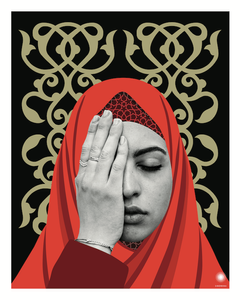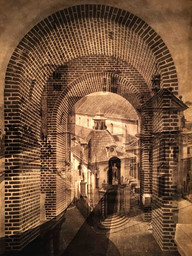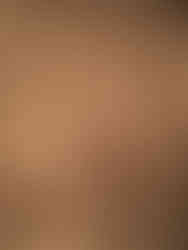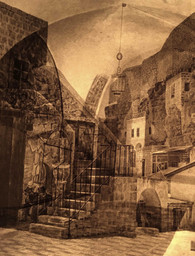Limited Edition: Artists' Prints
- hacerestrago
- Dec 6, 2020
- 8 min read
Updated: Feb 2, 2021
There is something magically intimate about gifting art. As art is highly personal, when selected thoughtfully and carefully, it can show a lucky recipient that you understand them and their artistic aesthetic. It can be challenging to confidently find the right piece of art to gift, but, if done correctly, art is one of the most meaningful gifts you can give.
Art prints are excellent alternatives to one-of-a-kind works as they're often less expensive, meaning you can take a gift-giving risk without breaking the bank. We've pulled together some of our favorite artists who offer prints of their pieces. Some are painters, some printmakers, some textile craftsmen, but all produce magnificent works of art that we would love to receive this holiday season! Also, don't be afraid to reach out to artists you love and ask if they can make a single print of a piece that isn't available (we've done this a few times with works of art that previously sold but that we can't live without!).
We start with Kelvin Mann. The New Zealand born Dublin resident offers a remarkably stunning collection of printed works. Mann's series on Black robins is one of our favorites. Ranging from a single image of the Eve of the Black robins, Old Blue, to a towering pyramid of hundreds of her descendants, the prints are enchanting retellings of the story of one powerful bird who helped rescued her species.
The Chatham Island robin or Black robin is native to a group of islands off the east coast of the South Island of New Zealand. Prior to the arrival of Polynesian and later European settlers, the country had effectively been a bird sanctuary...By 1979 the population had dwindled to only five birds, two female and three males. A conservation team lead by Don Merton embarked on a breeding program that involved taking the eggs before hatching and placing them in the nests of other birds, specifically the Chatham Island Tomtit. Of the two remaining females only one managed to successfully reproduce. She was named Old Blue after the blue band she wore for identification.
The average life span of a Black robin is 4 years. Old Blue lived to be 13 and is undoubtedly the mother of her species. Currently the population is approximately 250, each of which is a direct descendent of this remarkably little bird (1).
Mann's illustrative talent is undeniable. We love his ability to translate the soft feathered fragility of tiny birds through the linearity of etchings. We own one of his Old Blue prints and we cherish it; each time we see it, it's a motivating reminder of strength, perseverance, and natural beauty.
Alison Wake of Cognissant in central England also captures the essence of natural beauty. Wake's pieces, constructed using predominantly locally-sourced hand-dyed wool, are expressive thread paintings that depict the majesty of the Peak District National Park.
Whilst walking the paths and trails of the Peak District I see, hear, smell and feel the natural and manmade features which make this area so unique. I try to communicate my experience through the colour, texture and imagery of my pictures (2).
We especially adore her winter-scape embroidery prints (which are also available in card form!). The way Wake captures the trailing shadows of bare trees stretched over the snow using embroidered lines is absolute mastery and is an almost dizzying expression of artistic talent. The nuanced texture of the wool thread and the subtle shadowed contours of the embroidery translate beautifully to two dimensional paper. Each December, we replace some of the art in our homes with seasonal holiday pieces and Allison Wake's work is definitely included in this rotation!
Making our way to America, specifically to Palm Springs, California, we discover Gustavo Rimada, a Mexico-born artist and Army veteran who creates phenomenal tattoo-inspired paintings that feature vivid planes of solid saturated color, paperesque rose petals atop succulent thorny stems, and smoothly shadowed, almost porcelainized, portraits. The subjects of his pieces are depicted with such honor, strength, and grace that the images that have the ascendancy and presence of religious icons. Rimada's works are nothing short of bold, in the most outstanding way.
New Zealand's Rebekah Codlin paints equally beautiful portraits, but with hyperrealistic precision rather than the graphic stylization of Rimada. Every painting she shares is pure magic as well as a technical masterpiece. Her Ethiopia series, "[portraying] the raw beauty of people...[and] a common depth and complexity in humanity we all share when we strip back the layers"(3), depicts young Ethiopians adorned with subtly cracked traditional face paint. Codlin's ability to capture the humanity and authenticity of her subjects is spellbinding.
Our favorite pieces from Codlin are her portraits of Charlie. The mesmeric gaze, the illuminated contours of Charlie's body against a long supple black dress, and the subtle shadows of trees against the walls in the background all relay the "sense of peace and contentment one can have in their place of solitude". It's a truly successful and genuinely beautiful series that Codlin brilliantly offers as prints!
We take a turn to Rome next to find Sibomana, an Iranian-Belgian artist. We are so smitten with his work we actually struggled to find the words! His graphic street-art style pieces in the 'Waves of Heroes' collection feature black and white photographic portraits of refugees surrounded by collages of vibrant patterned scales resulting in a submersion of color and dynamic movement.
With the project Waves of the Heroes, initiated in 2015, Sibomana drew posters on immigration in the main cities of the European migrant routes. This posters can be seen in in Lesvos Island, Athens, Istanbul, Rome, Berlin and London. In 2016, he created a project with Kurema Kureba Kwiga (Art Collective from Rwanda) in Kigali, wich resulted in a series of twenty six portraits by ten different artists, reminding us the sacrifice and bravery of refugees (4).
They are striking and gloriously powerful—but not somber—depictions of the immigrant experience. With their flawless composition of color, pattern, and texture, these prints make phenomenal additions to any space.
The surrealist paintings of Jeremy Olson are downright cool. Featuring dramatic contrasting colors and appearing almost like digital renderings, Olson's pieces range from geometrically deconstructed faces (reminding us of Alma Haser) and tangled structures of glossy masticated gum, to weirdly aggressive anthropomorphized produce. This produce is the subject of his 'Three Musicians' print available from London's Unit Drops. The instruments themselves are botanical, played by an architectural mushroom (maybe an enoki?), a fanned leafy green kale, and a slithering snake-like bundle of asparagus. The tiered stage sits atop a richly organic brown floor that makes it seem as though the vegetation has been lifted from the soil. It's strange and fantastic and a really successful lithograph!
Jeremy Olson’s practice began with a considered exploration of geometric structure and fragmentation within portraiture. While retaining this interest in geometric structures through the presence of fictive architectural features, Olson’s practice has now morphed into an ultra-contemporary exploration of the grotesque(5).
Jo Israel also creates fantastic surrealist pieces. By layering pages of books atop each other in front of a small light source, Israel is able to photograph a jumbled and dizzying composition of overlapping imagery. The light renders the negative space of the pages a rich vibrant yellow that offers a striking contrast to the blacks of the printed images. When speaking with Israel, we learned that she creates these pieces at night by only the light she uses to illuminate the book pages and we were reminded of when we would read under the bed covers with a torch! It's completely magic!
My Betwixt series rescues images from time. I appropriate pages from bygone picture books that have images on either sides of the page. Through the process of shining light through the page I invite the previously separated images to meet and fuse, creating a metamorphic space where two worlds magically collide(6).
The final images are oddly haunting leaving us voyeurs of a surrealist tangled of forgotten images. They are riddled with transfixing texture, pattern, and unnatural beauty and we are consistently and very pleasantly awe-struck.
Entrancing in a slightly different way are the prints by Louisa Boyd. Webs of fragile cartographic lines and coils are corroded by invasive inky spots. The result is a series of stunning astronomical abstractions that are utterly enrapturing. We first saw one of Louisa Boyd's works in the flat of a male friend and the print felt so commanding and masculine that it brilliantly transformed the atmosphere of the space. We can't put into words how successful we think Boyd's prints are!
Anyone who knows us is aware of our infatuation with Ivan Bautista. We have yet to come across a single one of his pieces that isn't sheer perfection. We wrote a complete Artist Spotlight on Bautista if you are looking for more information about his work but we are confident that—as pictures are worth a thousand words—the images below will communicate how unparalleled his art is.
Next on our list is Turkish Aykut Aydogdu who created one of our all time favorite pieces of digital art, that happens to be available as a print. The piece, entitled "Black", is a contemporary interpretation of a classical painting featuring three stately, silken dobermans wrapped around a young woman clad in an ethereal gossamer dress. Her hazel eye, the only feature of her face in view, casts a salient feeling of saudade that blankets us with emotion. A large sumptuously regal earring drips onto her shoulder and offers a luminous counterpoint to the glossy coats of the dogs. This new media work is truly magnificent and will certainly be a statement piece of art in any home.
Next we share the work of British artist Neil Bousfield. In his pieces, scenes are distorted by layers of gradient lines and patterned blocks. Hatch marks offer additional texture and delineating geometry that beautifully emphasize the overlapping shapes. We love Bousfield's 'Land and Sea' series, where sharp speckled waves peak and spray, walls of rock are outlined with trailing white borders that offer contrast to the serenity of the horizon, and soft sage abstractions form collages that imply the division between land and sea. We also adore the prints Bousfield made available through the Artist Support Pledge; the tiled texture in 'Leslie Paton: Memorable Places' and the luminous white haze in 'Halvergate' are absolutely entrancing.
Moving through Europe to France, we find artist Lucie Spartacus who creates magnificently detailed linocuts and rubber stamps. What we appreciate about Spartacus's work is the thoughtfulness; while the imagery is highly and masterfully detailed, the faces are communicated with minimalist line work that allows for uninterrupted swaths of refreshing negative space. Spartacus's "Jane Morris" works are some of our favorites. Dense robes and blackened hair frame the lightness of Morris's skin and offer a sense of grounding contrast against a swarming filigree pattern reminiscent of William Morris's iconic designs. The prints are feminine and nuanced and, as they are available in deep inky navy and vintaged tomato colours, offer unique accents to any art collection
To conclude our list we want to feature two artists, Tabitha Whitley and Alan Altamirano. In our office, we have two of their pieces hanging as a pair. We are just overwhelmed by our love for the conversation the two works have; while they are both printed portraits of entrancing woman framed by flowers, the differing emotions and the energies are magnificently complementary.
Several members of our team confidently declare that this print by Alan Altamirano is their favorite piece of art. There is something about the haunting somberness of the subject's expression, effortlessly permeating the obstruction of a winding thread of linework, that leaves us breathless. The flowers aren't vibrant or joyful, rather they are fingers of leaves and petals that seem to bend to the waves of her blackened hair. It's nothing short of mesmerizing.
Tabitha Whitley's linocut piece, Afro Flowers, is similarly remarkable. The subject, with eyes closed, epitomizes serenity. A bouquet of joyous flowers bloom under her chin while chrysanthemum-like flowers embellish her magnificent coiled hair. Much like Altamirano's print, the conspicuous line work used to illustrate the face is beautiful without distracting or detracting from the expression of the woman. We just adore the print, especially in striking and balancing harmony with Altamirano's print.
Hopefully this list has inspired you to explore gifting art prints this holiday season! Should you be looking for even more print options, we recommend you check out Imprinted.





































































































Comments